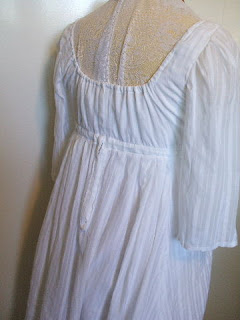This is such a quick and easy project, it hardly seems worth a post of it’s own. But hey, it’s something to post about, so why not?
Since I decided to try going to another Civil War event, and I would be sitting in an encampment making butter in a butter churn, I knew I was going to need an apron to wear over my dress, especially since I was planning on wearing my blue and white voile.
My CW friend Beth told me to just buy the Simplicity #7217 pattern, since it came with a pinner apron pattern. It’s the Fashion Historian line by Martha McCain, and I trust Martha (a very nice lady whom I’ve met at Costume College).

A pinner apron is so called because instead of having a tie around the neck, the top of the bib just pins to the bodice. It uses two straight pins or special pins made just for them. But I wasn’t able to find a photo of them to show what they look like. This pattern also has the waistband buttoning in the back instead of tied. I think this gives a much neater look that was so important to the Civil War silhouette.
Of course the fun part was looking for the fabric. I knew it should be dark, and I had to keep trying not to “coordinate” it with what I was going to wear. I didn’t have any luck looking on those $1 yd tables everyone is always bragging about but did find one at JoAnn’s that, with a 40% off coupon, I only paid $1.89 yd. It only takes 2 ½ yards.

Basically this pattern only has two pattern pieces, the bib and the waistband. Then the skirt is a 43” square. Since my fabric was 44” wide, I just left that additional inch on and my piece ended up with a selvedge finish on the sides.
The bib, even though cut to my size, was a little wide for my chest. So I cut about 2” off the sides but left the length as indicated. I sewed the bib right sides together, trimmed and turned right side out. I top-stitched ¼” in along the outside edges, but chose not to do the second row 2” from that. Then I did two rows of gathers along the bottom. The waistband pattern has marks on it where you attach it to the bib but basically it’s just gathered to cover the front of you, about 9 inches across. I used a piece of iron-on interfacing on one side of the waistband, then basted the waistband to the bottom of the gathered portion of the bib.


The skirt potion was really easy: turn under the sides and hem, which I did by machine. Turn up 3 ½ inches on the hem, and turn under the half inch. Again I machine stitched it.
I sewed two rows of gathering stitches along the top of the skirt, and gathered it to the bottom half of the waistband. Again the pattern has marks where you attach it, mine came out 5 inches past the side of the bib, pretty much lining up with my “side seam”.
The other half of the waistband is then sewn right sides together to the waistband but stopping at either side of the skirt. The waistband is trimmed, and turned right side out. Press, and slip stitch the opening in the middle to the top of the skirt.
The waistband will have two buttonholes and buttons in the back to close it.
This is just over a chemise on my dressform with no hoopskirt to fill it out so it looks long. It should be about 10 inches shorter than your dress skirt.














































